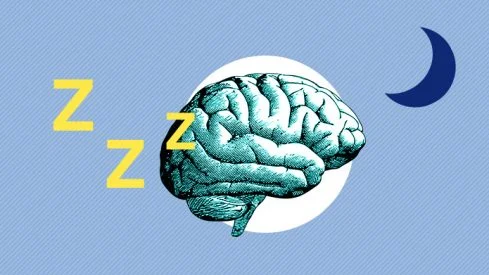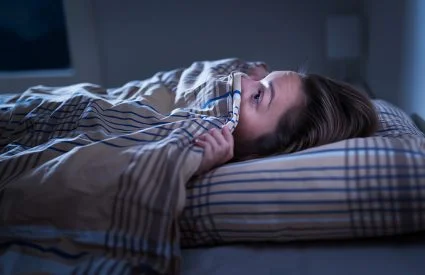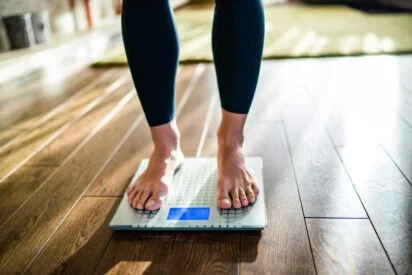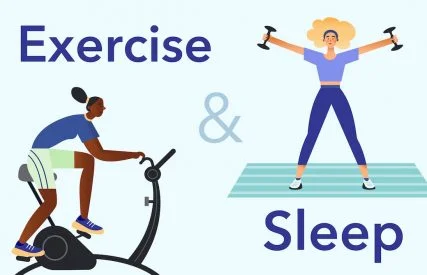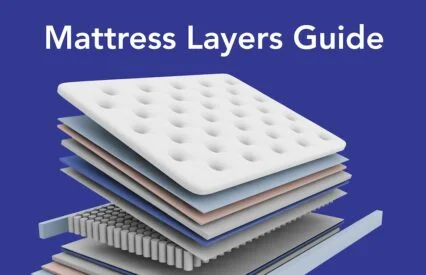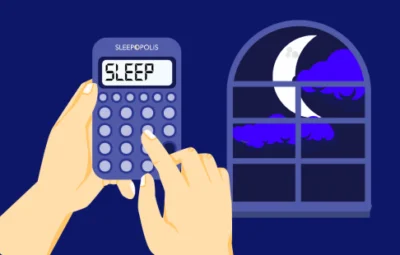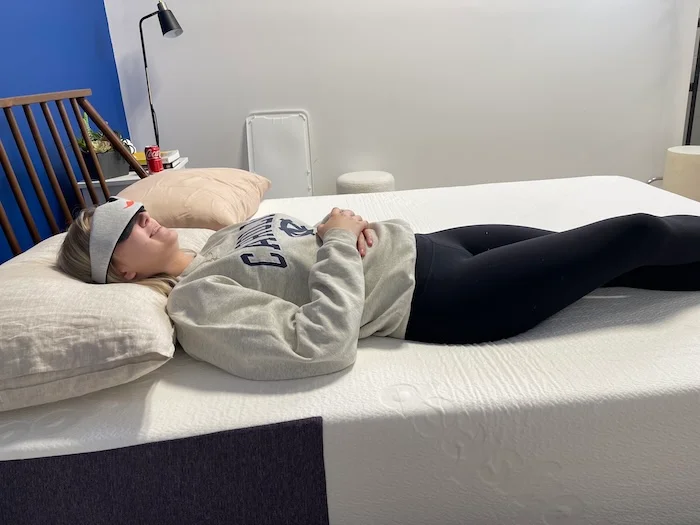Buying a new mattress sight unseen can be unnerving, no matter your budget. But if you’re on the hunt for a quality foam mattress with a wallet-friendly price tag, you’re in luck. The team of experts here at Sleepopolis put the affordable PolySleep Luna Mattress through its paces according to our medically approved testing methodology to see what works — and what doesn’t.
During testing, we were impressed with the solid construction and attention to detail evident in the Luna’s multi-layer, all-foam design and soft, breathable cover. With its medium feel, the PolySleep Luna is a good choice for light and average-weight side and back sleepers.
The Sleepopolis team has personally tested more than 330 mattresses and helped over 60,000 people find their own personal best mattress, so we’re well qualified to offer insights into the Luna’s materials, construction, performance, feel, and more. We also consulted with several experts for this piece, including Dr. Raj Dasgupta, MD, FACP, FCCP, FAASM, who helped create our testing methodology, and Dr. Shelby Harris, a licensed clinical psychologist.
The Polysleep Luna is a simple all-foam bed with three layers, and should be comfortable for back sleepers and side sleepers alike. It’s also more responsive than your average foam mattress, making a good match for combination sleepers who switch sleeping positions at night.
What our tester says:
““I could feel it relieving some tension in my lumbar region after moving from an upright seated position onto my back. Overall, this is a great mattress for back sleepers.” – Kenny Timper, staff writer and certified sleep science coach
PolySleep Luna Mattress Overview
The Canadian-made PolySleep Luna Mattress is a 12-inch memory foam mattress with a few notable upgrades. It has an antimicrobial top layer designed to inhibit bacterial growth for a cleaner, healthier sleep surface. The mattress cover is removable and machine washable, and the foam itself has an open-cell design that promotes airflow to combat heat retention. That can be an issue with memory foam, so this is a nice touch.
We scored the mattress a 6 out of 10 on the firmness scale and found it especially well-suited to side sleeping. During testing, our team found the bed contoured well beneath the shoulders and hips and had enough support to maintain a neutral spine — key considerations for side sleepers. The medium firmness worked equally well for back sleeping, with soft cushioning around the elbows, lower back, and feet to relieve pressure.
All PolySleep mattresses are beds-in-a-box, and the Luna is no exception. The mattress arrives tightly rolled and compressed in a box, making setup straightforward. Since it’s a foam mattress, there is no coil system adding weight, so it’s a relatively lightweight bed to get into place. Off-gassing is typical with foam beds-in-a-box, and the PolySleep Luna did have a telltale chemical odor that was noticeable after unboxing. However, it dissipated in roughly 24 hours.
During testing, the Luna mattress earned high marks for pressure relief with a score of 4.5 out of 5 stars. It performed less well in the cooling and edge support categories, earning 2.5 and 3.5 stars respectively. Overall, the PolySleep Luna mattress averaged 3.9 stars out of 5.
PolySleep Luna Mattress Value
When we judge value, it’s a reference to the price in relation to material quality, overall mattress construction, how well it performs, and its expected durability. Chief Medical Advisor Dr. Raj Dasgupta says that a durable mattress withstands wear and maintains its structural integrity over time. While memory foam mattresses aren’t the longest lasting options on the market (latex mattresses are known for their longevity and durability), the PolySleep Luna is nicely constructed with three foam layers, including a dense support base, a softer top comfort layer, and an antimicrobial top layer.
In terms of materials, the Luna has badges that speak to safety, like CertiPUR-US. This means the mattress materials have been tested for harmful chemicals, ozone depleters, and heavy metals (though CertiPUR-US is admittedly a somewhat complicated designator, which you can read more about on our certifications page). It’s also Antimicrobial Certified, so it’s resistant to allergens and irritants like dust mites and bacteria. That’s appealing to those with allergies and anyone interested in a cleaner mattress. The Luna measures 12 inches in height, so it falls somewhere in the middle of the pack compared to other options on the market and certainly means it’s tall enough for most sleepers.
Before seasonal discounts and promotions, a queen-size Luna Mattress is $1,375. But like many online mattress companies, there are regular sales that drop the price significantly, by hundreds of dollars. That puts the Luna into a more affordable category, especially given its solid construction. While the mattress fell short in a few areas, like cooling ability and edge support, that’s pretty typical for memory foam mattresses as a whole. Overall, we feel confident recommending the Luna for side and back sleepers in search of a quality memory foam mattress at an affordable price.
What is the PolySleep Luna Mattress Made Of?
The PolySleep Luna Mattress is simply constructed with three layers. On top is the antimicrobial top layer, which inhibits bacterial growth. Keep in mind that foam mattresses in particular tend to accumulate germs, dead skin cells, and sweat, so this soft, contouring layer of medical-grade antimicrobial foam can really contribute to a cleaner bed. Just below is a transition layer designed for exceptional motion isolation. It’s an important consideration for anyone who shares their bed with a partner or pet. The dense support foam at the base of the mattress serves as the Luna’s support base.
Cover – The PolySleep Luna has a soft, stretchy, breathable cover made with a polyviscose, polyester, and spandex blend. Notably, it’s removable so it essentially acts as a mattress protector. It’s also machine washable.
Comfort Layer – The top layer measures 2.5 inches of antimicrobial, open-cell hybrid foam that responds to heat and pressure for soft contouring.
Transition Layer – This 2-inch hybrid foam layer isolates motion and vibration for fewer nighttime disturbances.
Support Layer – A thick, high-density base layer measuring 7.5 inches.
PolySleep Luna Mattress Mattress Firmness
Firmness and feel are subjective features in a mattress because they’re a little different for everyone. Individual body type, weight, and preferred sleeping position all affect how we interpret a particular mattress’s firmness and feel. To make these ratings as useful and objective as possible, we rank firmness on a scale of 1 to 10, with 1 the softest and 10 the firmest. We also get firmness scores from multiple expert testers and use the average as our final firmness score.

A true medium-firm mattress ranks 6.5 out of 10, and the PolySleep Luna ran a touch softer than that at 6 out of 10. In other words, it’s a medium-soft mattress that balances support with soft cushioning — about what you’d expect from memory foam, which is known for its contouring effect. That makes it ideal for most side sleepers. It has plenty of contouring around the hips and shoulders, which can be susceptible to pressure point pain on a mattress that lacks sufficient give, but it doesn’t lack in spinal support. That’s key for any mattress.
If you’re an average-weight back sleeper who prefers a softer feel, the Luna is a good fit. It has a pleasing amount of sink without sacrificing the spinal alignment necessary for keeping aches and pains at bay.
On the other hand, the softer feel of the Luna mattress could pose an issue for stomach sleepers. During testing, we found it slightly too soft to keep the hips lifted and the spine straight. Plus, the soft cushioning made it difficult to get up from this position, which could be an issue if you need to get up for a middle-of-the-night bathroom visit.
PolySleep Luna Mattress Mattress Performance
It’s easy to focus entirely on how a mattress will feel and how much it costs. But overlooking performance metrics, like pressure relief, motion isolation, responsiveness, cooling ability, and edge support, can steer you toward a mattress that doesn’t address your needs and preferences. To help different sleepers get a better idea of what to expect from the PolySleep Luna, multiple Sleepopolis testers evaluated the mattress based on these performance categories.
Below, find a brief summary of each test and insights into the Luna’s performance.
PolySleep Luna Mattress Pressure Relief Performance
Pressure relief is a major consideration for many sleepers. According to Dr. Shelby Harris, memory foam helps relieve tension by contouring to the body’s curves, which is ideal for pressure relief. So it’s no surprise that the all-foam Luna performed well in this category. We scored it 4.5 stars out of 5, the average of our testers’ two scores, for both the side and back sleeping positions.
To assess how effectively the Luna mattress addresses pressure, we had both a lightweight tester (under about 130 pounds) and an average-weight sleeper (between 130 and 230 pounds) perform the test. Lightweight sleepers tend to find mattresses feel firmer than average because they don’t sink into the top layers as much. Average and heavyweight sleepers are able to sink in more, which makes mattresses feel softer.
We evaluate pressure relief by lying on the mattress for several minutes in two different positions: on our backs and on our sides. That gives our testers sufficient time to identify if and where any pressure might be building or eased. On her side, our lightweight tester Riley Otis noted a lot of sinkage on the Luna, which contoured nicely around the hips and shoulders, but found that the dense foam base balanced the sinkage well. Still, she noticed a touch of pressure buildup around the shoulders and hips and ultimately gave the mattress 4 stars out of 5. While Riley reports that this pressure was very slight and likely not enough to prevent her from sleeping comfortably on her side throughout the night, it could pose an issue for people with very sensitive joints and those with hip or shoulder pain.
When Riley tested pressure relief on her back, she found that the Luna performed very well. Her hips sank comfortably, but not enough to compromise spinal alignment. She also found plenty of deep contouring around her upper and lower back, which she describes as incredibly comfortable. For lightweight back sleepers, she scored the Luna 5 stars out of 5.
For our average-weight tester Kenny Timper, the Luna likewise earned full marks for pressure relief in the back-sleeping position thanks to an excellent balance of contouring and support. Despite its softness, the mattress didn’t dip around the lower half of his body, which Kenny says is a common issue on plush mattresses. Plus, the cushioning around his elbows, knees, hips, and shoulders was pleasingly noticeable.
The Luna Mattress was just as comfortable in the back sleeping position. Kenny noticed slight sinkage around the lower half of his body, but it wasn’t enough to create any discomfort. Despite feeling as though he was sinking into the bed, he reports feeling adequate support while resting on his back. “I could feel it relieving some tension in my lower back after moving from an upright seated position onto my back, but it’s not as effective as a hybrid mattress or a firmer model, which is my preference,” Kenny said. For that reason, the Luna earned 4 stars out of 5 for pressure relief for average-weight sleepers in the back-sleeping position.
PolySleep Luna Mattress Motion Isolation
Motion isolation is a key consideration for couples or those who share the bed with a pet. Motion isolation describes how well the materials in a mattress absorb movement and vibration, which minimizes disruptions if you have a bed partner who routinely changes position at night. Low motion transfer is ideal for couples, while high motion transfer is a better choice for those who sleep alone. Dr. Shelby Harris notes that memory foam mattresses provide minimal motion transfer, so we had high expectations for the PolySleep Luna. However, it earned an average overall score of 3.8 stars in this category.
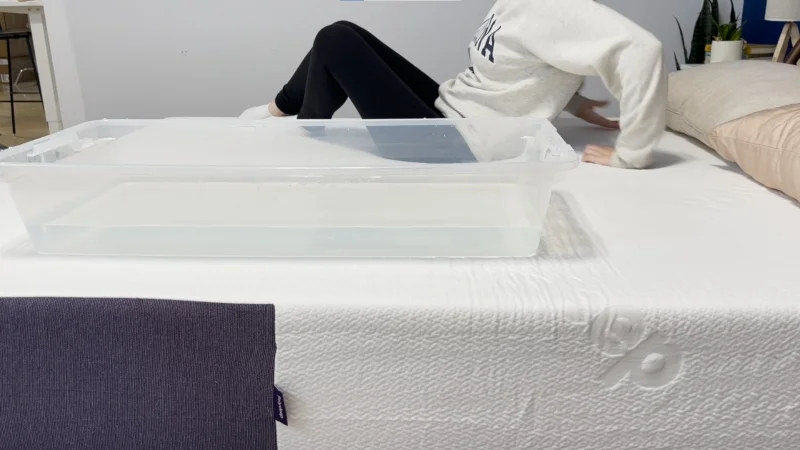
To assess motion isolation, we used both a ripple test and a partner test. During the ripple test, we put a basin of water on one side of the mattress and energetically changed position and rolled around on the other side. We observed the movement of the water as an indication of how well the mattress isolates motion transfer. That’s something memory foam usually does quite well. While the water wasn’t moving too aggressively in the basin when our tester changed position, it was more motion than we expected from an all-foam bed. “The ripples were primarily on the surface of the water and not really causing motion near the bottom of the tub,” Riley reported. We scored the Luna 4 stars out of 5 for the ripple test.
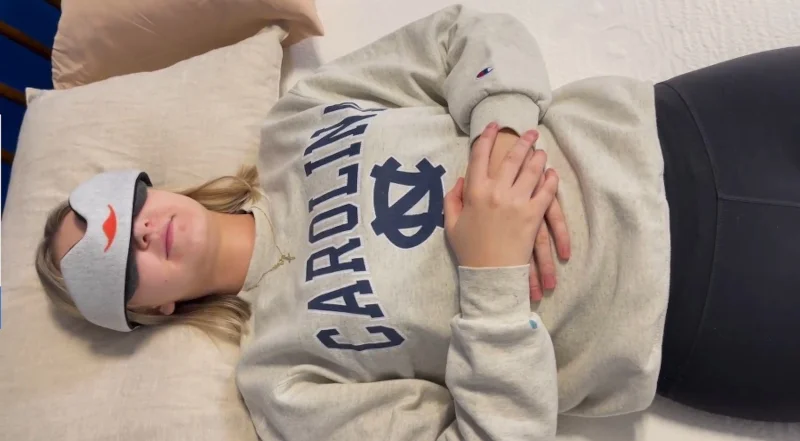
The mattress performed slightly worse during the partner test. During this test, we replaced the basin with a human tester, who wore a blindfold to better assess movement in the mattress. The Luna did a decent job muffling movement, but our tester could still feel her partner getting in and out of bed and switching between positions. The foam absorbed some motion, but light sleepers may still experience sleep disturbances if they share the bed with a restless partner. In this category, we scored the Luna 3.5 out of 5.
PolySleep Luna Mattress Responsiveness
On the flip side of motion transfer is responsiveness. This describes how quickly the bed returns to its original shape after pressure is removed, such as when you roll from your back to your side. All-foam mattresses aren’t traditionally very responsive, because they lack those bouncy spring coils. To assess responsiveness, our team relies on four separate tests — three are objective and one is subjective.
Switch test: During the switch test, our tester rests on the mattress and moves from their back to their side to their stomach. If these transitions are easy to do, with no slow-moving foam layers that inhibit their movement, it’s an indication of high responsiveness. Memory foam isn’t known for this ability, but the Luna somewhat exceeded expectations here. That’s probably due to the dense support layer. While our testers didn’t find it too difficult to switch from their sides to their backs or stomachs, it was more challenging to go from their stomachs to their backs. That’s why we scored the Luna 3 stars out of 5.
Combination sleepers and those with bigger bodies may find themselves wrestling with the Luna mattress when moving from one position to the next, so a firmer mattress with a faster response time is likely a better option.
Responsiveness test: To perform the responsiveness test, we use a 53-pound kettlebell. It’s placed on the mattress for seven seconds, then removed by pulling straight up. We use a stopwatch to time how long it takes for the mattress to return to its original shape. The PolySleep Luna took .29 seconds. That’s remarkably quick, earning the mattress a full 5 stars.

Sinkage test: The sinkage test also uses a kettlebell, which is placed at the very center of the mattress. We use a ruler to measure how far the weight sinks into the mattress. In this case, it was 3.5 inches, which is an inch less than average compared to other mattresses we’ve tested. That indicates a moderate amount of body contouring and a reasonable amount of cushioning.
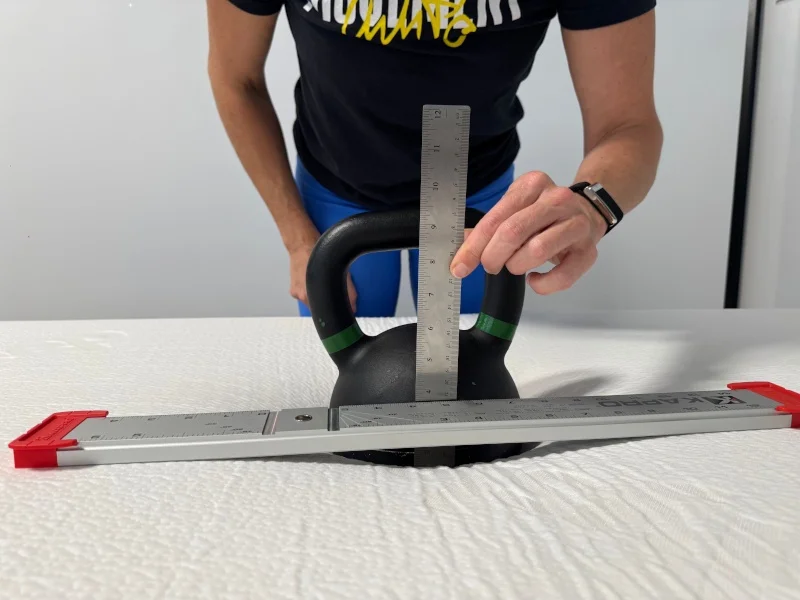
Bounce test: For our final responsiveness test, we drop a 25-pound steel ball from 6 feet above the mattress. Then, we use a yardstick to measure how high it bounces. On the PolySleep Luna, the ball bounced a full 21 inches, which indicates high bounce and earned the mattress 5 stars. That’s hard to do on an all-foam mattress!
PolySleep Luna Mattress Cooling
Some mattress materials trap heat more than others, and memory foam is unfortunately one of the worst. The material is dense and not particularly wicking, so it tends to hold onto heat and sweat — even when it’s an open-cell foam. To assess the cooling prowess of the PolySleep Luna, we performed three tests. As expected given the material, the Luna earned 2.5 stars out of 5 based on its performance in all three tests.
Thermal gun test: This test involves data from a thermal gun. We measure the starting temperature of a mattress before our testers lie down on it for 5 minutes. Then we measure it again. A temperature increase of fewer than 5 degrees means a mattress has excellent cooling. An increase of 5 to 10 degrees indicates good cooling ability, while 10 to 15 degrees means decent cooling. Poor cooling is a temperature increase of 15 degrees or more.
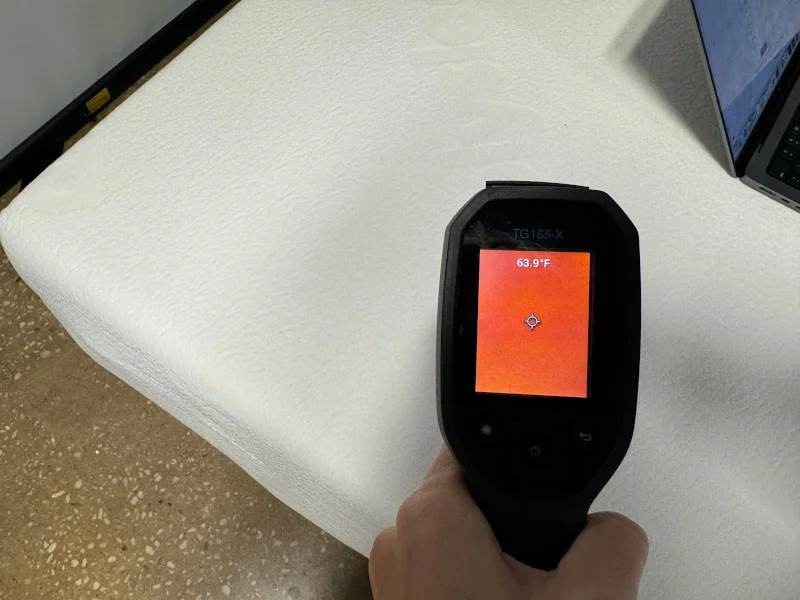

The PolySleep Luna had a starting temperature of 63.9 degrees. After 5 minutes, it had increased to 76.4, an increase of 12.5 degrees. That indicates a decent cooling ability, so we gave it a score of 2.5 stars. Again, this is pretty typical with memory foam mattresses.
Cover test: Before performing the thermal gun test, our tester felt the cover of the PolySleep Luna mattress. The mattress doesn’t have active cooling technology, but the cover is made with a breathable polyviscose/polyester/spandex blend. It doesn’t feel cool to the touch, but neither is it warm.
Feel test: This is an assessment of whether heat builds while our tester lies on the mattress for five minutes. Despite the Luna’s relatively low marks in the cooling category overall, our tester didn’t experience a noticeable increase in temperature. She says the mattress stayed on the cooler side throughout the entire five-minute test.
Exceptionally hot sleepers don’t generally do well with memory foam mattresses, unless they have gel infusions or cooling upgrades that combat heat retention. But if overheating at night isn’t an issue, the PolySleep Luna could be a good fit.
PolySleep Luna Mattress Edge Support
Edge support is another important consideration for couples. It describes support that extends all the way to the sides of the mattress, which maximizes surface area for more sleeping space. A mattress with poor edge support can make you feel like you’re about to roll off the side of the bed. It can be a common issue with all-foam beds, which often lack the reinforcement around the perimeter that you’ll find in hybrid mattresses with coil layers.
To test edge support on the Luna Mattress, we performed three tests. Overall, the Luna scored a little higher than expected for a memory foam bed with 3.6 stars out of 5.
Tape measure test: This test is objective. We stack weighted plates on the side of the mattress and measure how far it collapses. Our testers use three stacks to represent three weight classes: a 99-pound stack, a 154-pound stack, and a 198-pound stack. On the Luna, the lightest stack measured a 3-inch sinkage. The medium stack measured a 4-inch sinkage, and the heavy stack measured a 5-inch sinkage. We combined the ratings to give the Luna an average of 4 stars for the tape measure test.
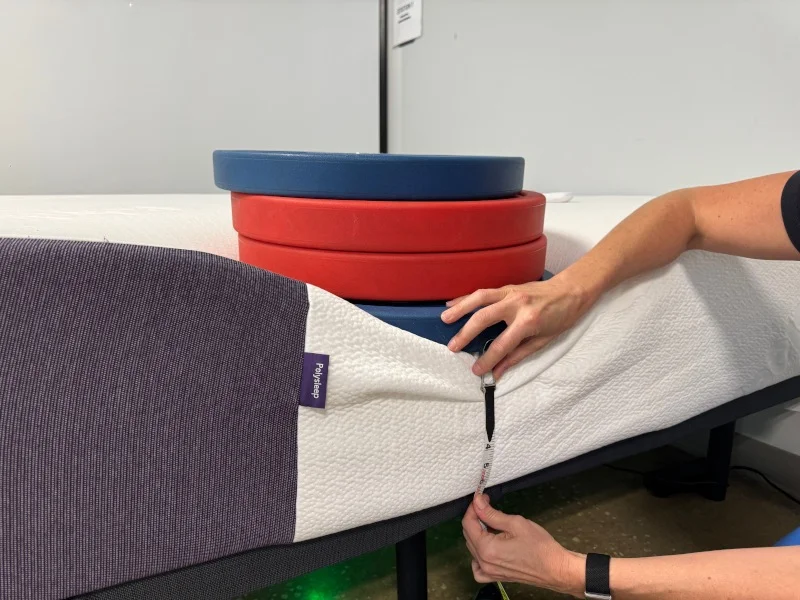
Seated test: During the seated test, a tester sits on the edge of the bed with their feet on the floor, then repeatedly stands and sits. They pay close attention to how supported they feel, and whether it seems necessary to use their hands to press up to standing. While our tester Kenny reported quite a bit of sinkage, he didn’t find it difficult to get in and out of bed from a seated position, earning the Luna a 3-star rating. When he used his hands for assistance, the layers visibly collapsed. People with mobility issues or those who use the sides of the mattress for support when getting up and out of bed might not find the Luna’s perimeter strong enough.
Full body test: Our tester Kenny lay on his back, side, and stomach on the edge of the mattress to assess its stability. Like the seated test, the support here was fair and earned the same 3-star score. An average-weight sleeper, Kenny could feel the edges sinking slightly but never felt concerned about actually rolling off the bed. Still, if you often sleep close to the edge, you may find it difficult to comfortably switch positions on this part of the bed.
PolySleep Luna Mattress Mattress Performance for Couples
For couples, the most relevant considerations in a mattress are typically cooling ability, motion isolation, responsiveness, and edge support. The PolySleep Luna Mattress performed moderately well in these categories. While there are better mattresses for couples, this isn’t a bad choice.
In the interest of peaceful nights, good motion isolation is usually high on the list of desirable features in a mattress for couples. The Luna scored 3.5 stars out of 5, but our testers cautioned that light sleepers might notice movement from a restless partner. The Luna also had an issue with edge support. We gave it 3.6 stars out of 5, and it’s reasonable to assume that bed partners will find themselves avoiding the sides of the bed in order to feel properly supported.
The Luna’s scores dipped on both cooling ability and responsiveness, with 2.5 and 3 stars, respectively. It’s normal for a bed to heat up faster when there are two sleepers instead of just one, and the Luna doesn’t have any active cooling upgrades. If overheating is an issue for either partner, this mattress may pose an issue. As for responsiveness, it’s an important consideration for sexually active couples because it makes it easier to move around comfortably on the bed. The Luna didn’t perform too badly here, but there are definitely more responsive mattresses to be found.
Other Performance Factors to Consider
It can be helpful to assess a mattress by considering additional factors, like whether it makes any noise or its compatibility for sex and with adjustable bases. We assessed the PolySleep Luna to give you an idea of performance in these categories as well.
Sex
Our score for sex is based on the average score from the responsiveness, cooling, and edge support tests. That’s because these factors can improve the experience. The best mattress for sex is responsive enough for ease of movement and minimizes heat retention with sufficient cooling ability. Strong edges can be important too, giving couples room to roam. The Luna earned 3 stars for responsiveness, 2.5 stars for cooling, and 3.6 stars for edge support, which gives it an overall score of 2.9 for sex.
Noise
One of the benefits of all-foam mattresses is their silence. Our tester did her best to make noise on this bed by jumping up and down, rolling around, and firmly pressing on it in different spots. There are no springs that might start squeaking down the road, and our tester didn’t hear sound escaping from the foam either. That’s why the Luna mattress earned a full 5 stars for its complete lack of noise.
Base Compatibility
If you have an adjustable base, mattress compatibility is key. In our testing studio, we have an adjustable base for testing purposes. “While the Polysleep Luna mattress fits well on an adjustable bed frame when lying flat, it struggles to stay aligned once the base is raised into various positions,” says tester Erin Chiles. We noticed a significant gap at the base, and the top layer material bunched up noticeably at the crease. These issues affect both comfort and appearance, so we scored the Luna 3 stars out of 5. People who frequently use adjustable settings on their adjustable base may find the Luna isn’t as compatible as other options on the market.
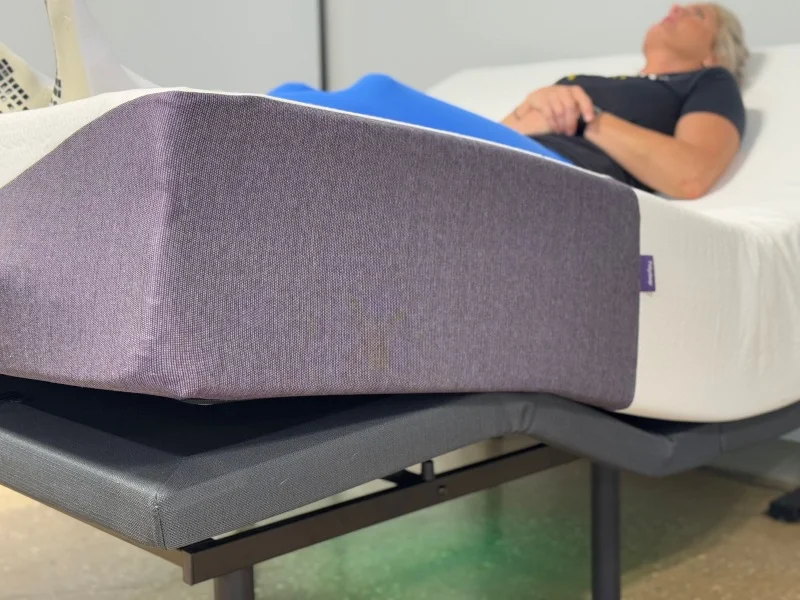
Durability
A mattress is an investment, and it’s reasonable to expect long-term durability. While it’s impossible to know how long a mattress will last, you can make a reasonable prediction based on material quality and construction. A warranty can be helpful as well, indicating how long a company expects its product to perform.
Polysleep offers a 10-year warranty on the Luna mattress, and the mattress is made with good quality materials that have earned third-party certifications for safety. With all-foam mattresses, dense support layers are critical to avoid premature sagging and indentations. Based on its materials and construction, we expect the Luna to perform as expected for 5 to 10 years. That timeframe is when Dr. Shelby Harris says most mattresses should be replaced.
PolySleep Luna Mattress Performance Scores
| Test | Product Score | Average Score |
| Firmness | 6 | 6.7 |
| Pressure Relief Side | 4.5 | 3.5 |
| Back Pressure Relief | 4.5 | 4 |
| Motion Isolation | 3.8 | 4 |
| Responsiveness | 3 | 4.2 |
| Cooling | 2.5 | 4.1 |
| Edge Support | 3.6 | 4 |
| Bounce Height | 21 | 16.3 |
| Bounce Rating | High | Moderate |
| Sinkage | 3.5 | 3.7 |
| Sex Score | 2.9 | |
| Noise | 5 | 4.5 |
| Off-Gassing | ||
| Trial Period | 3 | 4.3 |
| Warranty | 3.5 | 4.6 |
| Full Rise | ||
| Unboxing/Moving | 3.5 |
PolySleep Luna Mattress Sleeping Position and Body Weight
Both your body type and preferred sleep style play a role in how a particular mattress will perform. Here’s what to expect from the Luna mattress for back, side, and stomach sleepers in different weight classes.
Before we dive into our recommendations, though, we want to recognize that people come in all shapes and sizes, and people of every size deserve a mattress that works for their body type. We use the weight categories light, average, and heavy to more easily categorize sleepers based on how mattresses will perform for their body type, as most mattresses are designed for the group we call “average” (130 to 230 pounds).
As a general takeaway, lighter sleepers don’t require as much support as average-weight sleepers, and mattresses will tend to feel firmer to them. On the other hand, heavy sleepers tend to need more support than average-weight sleepers and tend to sink into the mattress more. As far as sleeping positions go, side sleepers tend to need a softer mattress while stomach sleepers usually need a firmer, more supportive one. Back sleepers are usually somewhere in the middle.
Is the PolySleep Luna Mattress a Good Mattress for Light Sleepers (Under 130 pounds)?
- Light Back Sleepers – The Luna should deliver sufficient sinkage at the hips without compromising spinal support.
- Light Side Sleepers – Unless you have very sensitive joints or preexisting hip or shoulder issues, the Luna should provide the necessary balance of cushioning and support.
- Light Stomach Sleepers – The Luna is soft, but lightweight stomach sleepers should find it supportive enough to prevent hips from drooping.
Is the PolySleep Luna Mattress a Good Mattress for Average-Weight Sleepers (130–230 pounds)?
- Average-Weight Back Sleepers – These sleepers will fare very well on the Luna, which balances soft cushioning with deeper support for a neutral spine.
- Average-Weight Side Sleepers – The Luna is ideal for this group, with ample cushioning for the hips and shoulders and proper spinal alignment.
- Average-Weight Stomach Sleepers – The Luna is likely too soft to keep the hips properly elevated, which could lead to lower back pain.
Is the PolySleep Luna Mattress a Good Mattress for Heavy Sleepers (over 230 pounds)?
- Heavy Back Sleepers – The PolySleep Luna likely lacks the support necessary for heavy sleepers in any position, and it’s soft enough to lead to bottoming out. The best mattress for heavy people is reinforced to support more weight, with ample edge support and cooling upgrades.
- Heavy Side Sleepers – See above.
- Heavy Stomach Sleepers – See above.
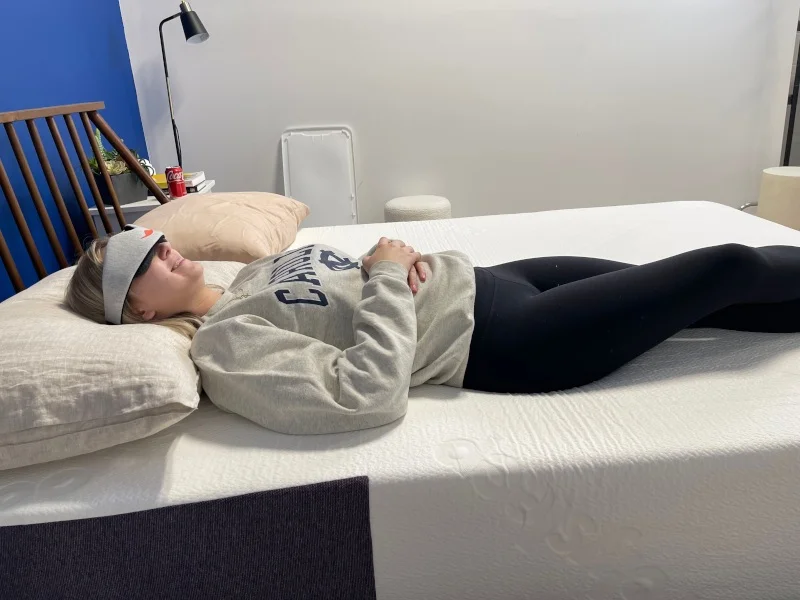
My Final Thoughts About the PolySleep Luna Mattress
If you’re looking for quick takeaways, here’s what to know about the PolySleep Luna Mattress.
Who I Recommend the PolySleep Luna Mattress For
- Average-weight side sleepers will appreciate the soft cushioning for hips and shoulders and stable support layer that keeps the spine straight and aligned.
- Budget shoppers can score a queen Luna mattress under $1,000 during the brand’s regular sales.
- Average-weight back sleepers who appreciate a softer mattress will like the gentle contouring.
- Average-weight combination sleepers should also fare well on the Luna and find it easy to switch positions.
Who I Don’t Recommend the PolySleep Luna Mattress For
- Heavyweight sleepers will find the PolySleep Luna too soft, which could lead to aches and pains.
- Couples may find the mattress falls short in edge support, cooling ability, and responsiveness.
PolySleep Luna Mattress Pricing and Sizing
Price is an important consideration, and frequent sales make the Luna mattress a great value buy. Here’s what it costs before promotional pricing.
| Size | Price |
| Twin | $1045.00 |
| Twin XL | $1095.00 |
| Full | $1275.00 |
| Queen | $1375.00 |
| King | $1595.00 |
| California King | $1595.00 |
PolySleep Luna Mattress Policies
| Warranty | 10 years |
| Sleep Trial Period | 100-night trial |
| Shipping/Returns | Free shipping in the U.S and Canada |
| Unboxing | The mattress arrives rolled and compressed in a box at your door. |
| Full-Rise | The mattress begins to inflate immediately after unboxing. It’s ready to sleep on within a few hours, but off-gassing is likely for up to 24 hours. |
| Customer Reviews | PolySleep mattresses have earned a 4.7-star rating based on 1,600+ customer reviews. |
PolySleep Luna Mattress vs. Competitor
If you’re on the hunt for a budget-friendly foam mattress, there are a lot of options on the market. Here’s how the PolySleep Luna compares to a popular memory foam mattress from Nectar.
PolySleep Luna Mattress vs Nectar Classic Memory Foam
Like the Luna, the Nectar Classic is a 12-inch memory foam mattress. Both mattresses are reasonably priced, but the Nectar is less expensive and includes a cool-to-the-touch surface layer that might appeal to hot sleepers. It has a medium-firm feel with a 6.5 rating out of 10 on the firmness scale. Plus, it comes with a generous 365-night sleep trial and lifetime warranty. We think it’s a good choice for stomach sleepers, which isn’t typical with memory foam.
- Price: The Nectar Classic is $649 for a queen, so it’s a better deal than the PolySleep Luna.
- Sleeping position: Stomach sleepers are better off with the Nectar, but side sleepers will find the Luna more cushioning. Back sleepers will do well on either mattress.
- Cooling: The Nectar earned 4.5 stars in our cooling tests, so it’s the better choice for hot sleepers.
- Body weight: The Nectar Classic has more support, so it’s a better option for heavier back and side sleepers.
Read more in our full Nectar Classic mattress review.
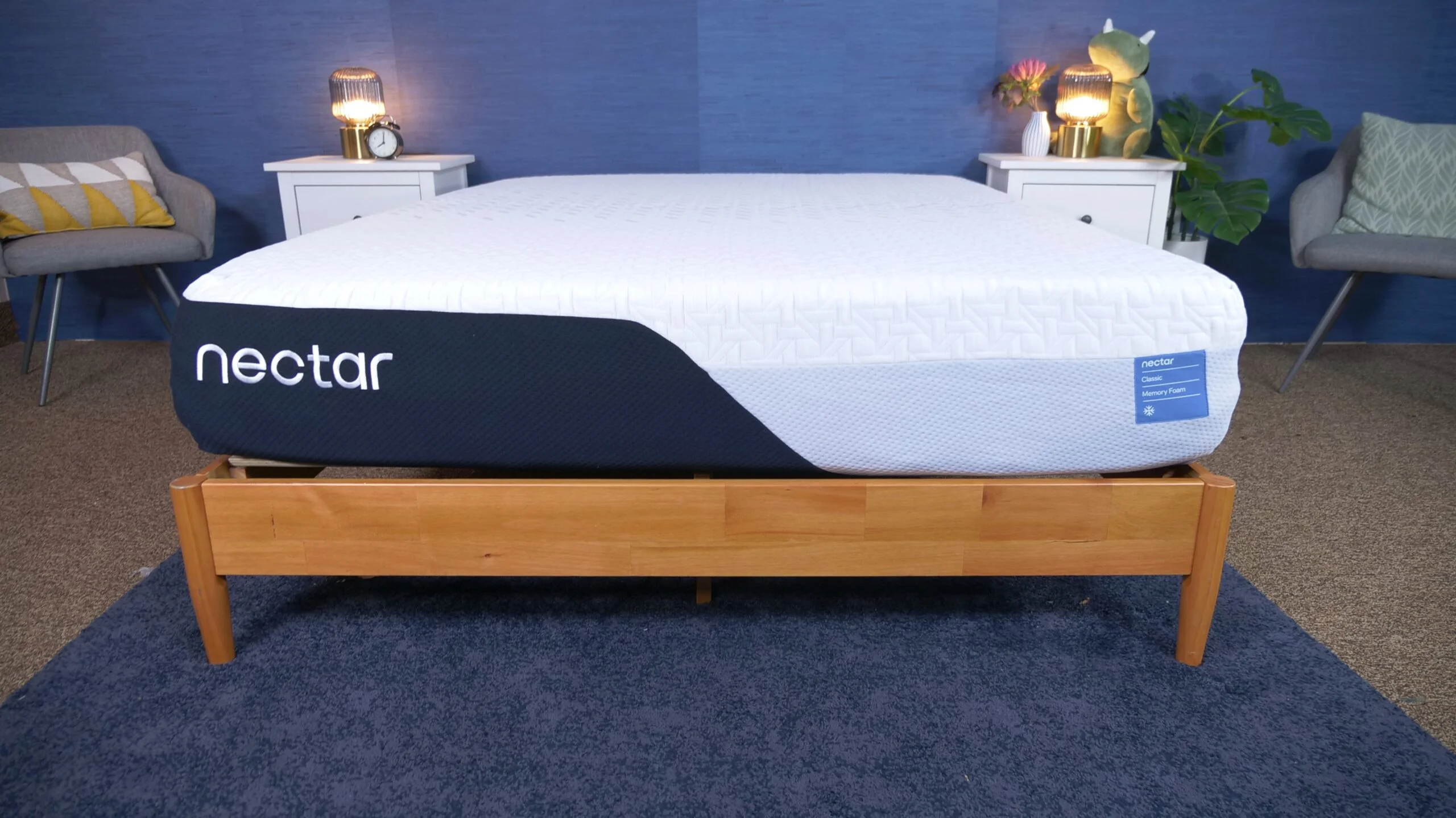
Nectar Mattress

Product Details
Our Recommendation
Financing Options
Financing options are available for this mattress.
Other Models from PolySleep
Interested in another PolySleep mattress? Here’s how the Luna compares to the more affordable Sierra model.
PolySleep Luna vs PolySleep Sierra
The Sierra is PolySleep’s budget mattress. It’s 9 inches tall and backed by a 5-year warranty. Both mattresses are made entirely of foam and share the same firmness rating of 6 out of 10, but the Luna outperformed the Sierra overall during our tests. While the Sierra is the better choice if you’re shopping solely on a tight budget, the Luna is the upgraded pick for average-weight side and back sleepers. While you’ll spend less on the Sierra, it comes in limited sizes.
- Price: A queen-size Sierra is $690 before sales pricing, so it’s definitely a value buy.
- Sleeping position: Average-weight back sleepers will fare best on the Sierra, but it lacks the contouring and support for most side sleepers and heavyweight sleepers in any position.
- Cooling: The Sierra actually outperformed the Luna on cooling, earning 4 out of 5 stars.
- Body weight: Heavy sleepers should look for different models altogether to ensure they’re getting the support they need.
Read more in our full Polysleep Sierra mattress review.
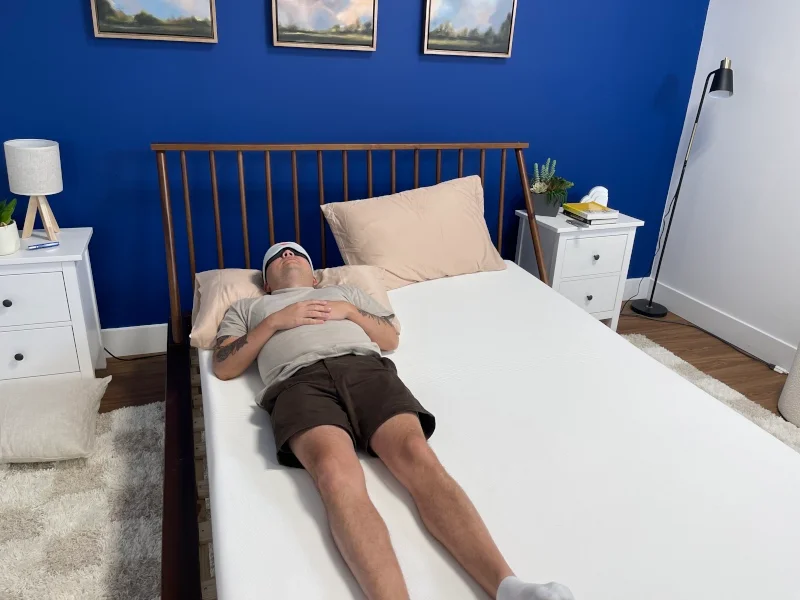
Polysleep Sierra

Product Details
Our Recommendation
Our Review Process
At Sleepopolis, our team of certified sleep science coaches personally test each mattress. We start by unboxing the mattress to figure out how difficult (or easy) it is to get the mattress from the box to the bed. Then, we spend time lying on the bed in different positions, taking time to assess it on our backs, stomachs, and sides. Next, we perform our Sleepopolis tests, using specialized tools to measure qualities like motion transfer, bounce, and pressure relief. Our last step is to open up the mattress and take a look at each layer. These steps allow us to give our final verdict on the mattress.
FAQs
Does the PolySleep Luna mattress come with a sleep trial period?
Yes, the PolySleep Luna comes with a 100-night sleep trial.
Does the PolySleep Luna mattress come with a warranty?
The PolySleep Luna has a 10-year warranty.
Is the PolySleep Luna made in the USA?
No. PolySleep mattresses are made in Canada, but they still ship for free to the United States.
How firm is the PolySleep Luna mattress?
We rated the PolySleep Luna a 6 out of 10 on the mattress firmness scale, making it a medium-soft mattress.
